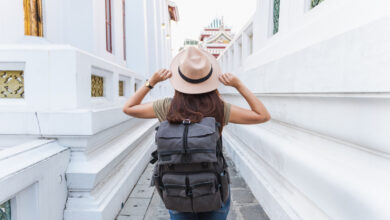Chichen Itza is an ancient city located in the Yucatan Peninsula of Mexico. It is considered one of the most important Mayan archaeological sites and is recognized as a UNESCO World Heritage site. Chichen Itza was the political and cultural centre of the Mayan civilization during the Classic and Post-Classic periods, which lasted from 600 AD to 1200 AD. Today, it remains a popular tourist destination and a symbol of the rich cultural history of the region.
The name Chichen Itza means “at the mouth of the well of the Itza,” referring to the cenote located in the centre of the city. Cenotes are natural sinkholes formed by the collapse of limestone bedrock and were considered sacred by the Mayans, who used them for both water sources and ritual sacrifices.
Chichen Itza was founded around 600 AD, but it was not until the 9th century that the city began to prosper as a major cultural and economic centre. The city’s architecture and urban planning reflect the Mayans’ sophisticated understanding of astronomy and their reverence for the natural world.
One of the most iconic structures at Chichen Itza is the Kukulkan Pyramid, also known as El Castillo. This pyramid is a testament to the Mayans’ impressive engineering and architectural abilities, as it was constructed with precision and accuracy that allowed it to align with the equinoxes and solstices of the year. The pyramid also features a series of serpent heads that can be seen during certain times of the day when the light hits the pyramid at just the right angle.
Another notable structure at Chichen Itza is the Temple of the Warriors, which features a large plaza surrounded by columns and statues. The temple was likely used for military ceremonies and was decorated with intricate carvings and sculptures depicting warriors and deities.
The Ball Court at Chichen Itza is another impressive structure, measuring 168 meters long and 70 meters wide. It was used for the ancient Mayan ballgame, which was a ritualistic sport played by two teams using a rubber ball. The game was seen as a representation of the struggle between the forces of light and darkness, and the winners were often considered to have divine favour.
Chichen Itza also features a variety of smaller structures and buildings, including the Temple of the Jaguars and the Temple of the Descending God. These structures feature intricate carvings and sculptures that provide insight into the Mayans’ rich mythology and religious beliefs.
Overall, Chichen Itza is an impressive testament to the Mayan civilization’s sophistication and cultural richness. The city’s architecture and urban planning reflect the Mayans’ deep understanding of astronomy and the natural world, while its artwork and iconography provide a glimpse into their complex religious and mythological beliefs. Today, Chichen Itza remains an important cultural site and a popular tourist destination, drawing visitors from all over the world to marvel at the ancient city’s impressive legacy.
Best Time to Visit Chichen Itza
The best time to visit Chichen Itza depends on your preferences and priorities. The weather in the Yucatan Peninsula can be hot and humid throughout the year, so it’s important to keep that in mind when planning your trip.
The peak tourist season in Chichen Itza is from December to April when the weather is drier and cooler. This is also the busiest time of the year, with larger crowds and higher prices for accommodations and tours. If you prefer to avoid crowds and have a more peaceful experience, it may be best to visit during the off-season from May to November, when the weather is warmer and more humid.
One factor to consider when planning your visit is the annual equinox on March 20th or 21st, when the sun creates a serpent-like shadow on the Kukulkan Pyramid, also known as El Castillo. This is a particularly popular time to visit Chichen Itza, as many people come to witness this spectacular event. If you’re interested in seeing this phenomenon, it’s best to plan your trip around this time and book your tickets in advance.
Heading for Chichen Itza? Grab a Guide
It’s also important to consider the time of day when you visit Chichen Itza. The site is open from 8 am to 4:30 pm, and it’s recommended to arrive early in the morning or later in the afternoon to avoid the hottest part of the day and the largest crowds. Additionally, visiting during weekdays can be less crowded than at weekends, as many locals also visit the site on weekends.
Ultimately, the best time to visit Chichen Itza depends on your preferences for weather, crowds, and activities. It’s important to plan ahead and book your tickets and accommodations in advance, particularly during the peak tourist season and around the equinox.
Average Temperature at Chichen Itza
The average temperature at Chichen Itza can vary depending on the time of year. The Yucatan Peninsula has a tropical climate, with hot and humid weather throughout much of the year.
From December to April, which is the peak tourist season, the average temperature ranges from 75 to 85 degrees Fahrenheit (24 to 29 degrees Celsius), with lower humidity and less rainfall. During this time, the weather is generally drier and cooler than the rest of the year.
From May to November, which is the off-season, the average temperature ranges from 80 to 95 degrees Fahrenheit (27 to 35 degrees Celsius), with higher humidity and more rainfall. The rainy season typically begins in May and lasts through October, with the heaviest rainfall occurring from June to September.
Regardless of the time of year, it’s important to come prepared for the heat and humidity by wearing lightweight, breathable clothing and staying hydrated throughout your visit. Sunscreen and a hat are also recommended to protect against the strong tropical sun.
Credits
Photo: The Kukulkan Pyramid at Chichen Itza. Photo by: Filip Gielda on Unsplash




